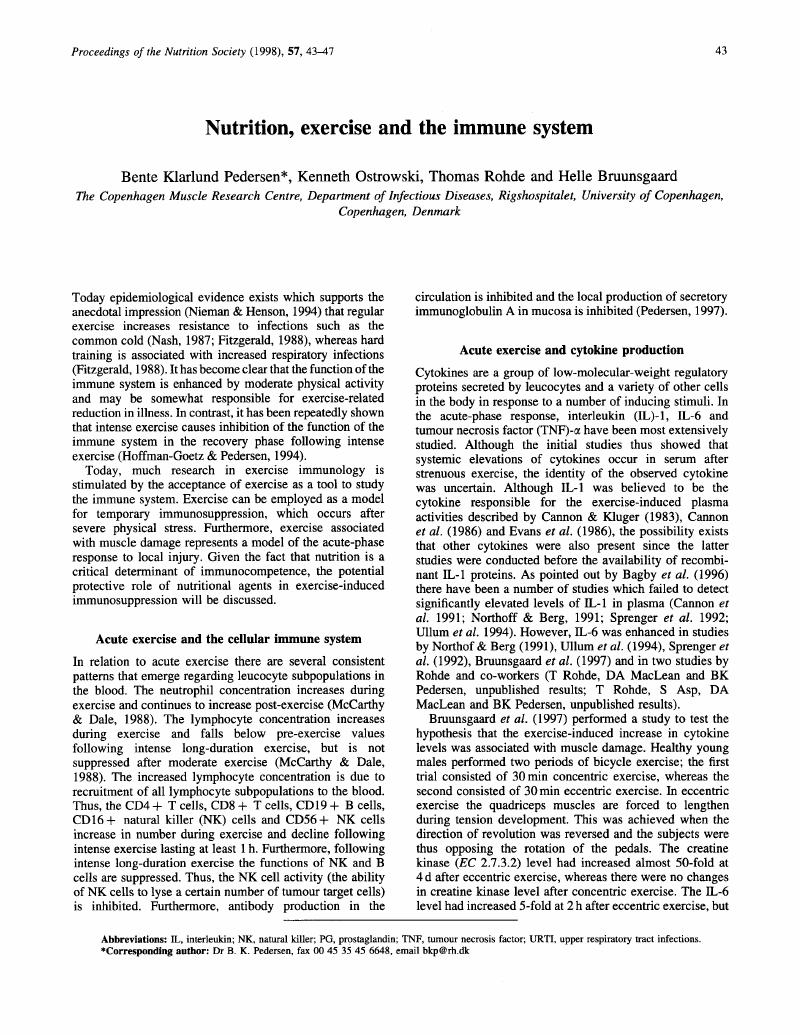Crossref Citations
This article has been cited by the following publications. This list is generated based on data provided by Crossref.
Nieman, David C.
1999.
NUTRITION, EXERCISE, AND IMMUNE SYSTEM FUNCTION.
Clinics in Sports Medicine,
Vol. 18,
Issue. 3,
p.
537.
König, D.
Grathwohl, D.
Northoff, H.
and
Berg, A.
2000.
Phytopharmaka VI.
p.
145.
NIEMAN, DAVID C.
2000.
Is infection risk linked to exercise workload?.
Medicine & Science in Sports & Exercise,
Vol. 32,
Issue. Supplement,
p.
S406.
Nieman, David C.
2000.
Endurance in Sport.
p.
731.
Pedersen, Bente Klarlund
and
Hoffman-Goetz, Laurie
2000.
Exercise and the Immune System: Regulation, Integration, and Adaptation.
Physiological Reviews,
Vol. 80,
Issue. 3,
p.
1055.
Nieman, David
2000.
Nutrition and Exercise Immunology.
Vol. 20001771,
Issue. ,
Krzywkowski, Karen
Petersen, Emil Wolsk
Ostrowski, Kenneth
Kristensen, Jens Halkjær
Boza, Julio
and
Pedersen, Bente Klarlund
2001.
Effect of glutamine supplementation on exercise-induced changes in lymphocyte function.
American Journal of Physiology-Cell Physiology,
Vol. 281,
Issue. 4,
p.
C1259.
PEDERSEN, BENTE KLARLUND
and
STEENSBERG, ADAM
2002.
Exercise and hypoxia: effects on leukocytes and interleukin-6???shared mechanisms?.
Medicine & Science in Sports & Exercise,
Vol. 34,
Issue. 12,
p.
2004.
Pedersen, Bente Klarlund
2005.
Natural Immunity.
Vol. 5,
Issue. ,
p.
263.
Klossner, Stephan
Däpp, Christoph
Schmutz, Silvia
Vogt, Michael
Hoppeler, Hans
and
Flück, Martin
2007.
Muscle transcriptome adaptations with mild eccentric ergometer exercise.
Pflügers Archiv - European Journal of Physiology,
Vol. 455,
Issue. 3,
p.
555.
최혜진
2008.
Effect of Power Walking Program on the Immune Response in Human Body.
Exercise Science,
Vol. 17,
Issue. 1,
p.
1.
최혜진
2008.
Effect of Power Walking Program on the Immune Response in Human Body.
Exercise Science,
Vol. 17,
Issue. 1,
p.
1.
Gleeson, M.
2013.
Diet, Immunity and Inflammation.
p.
652.
Eliakim, Alon
Falk, Bareket
Armstrong, Neil
Baptista, Fátima
Behm, David G.
Dror, Nitzan
Faigenbaum, Avery D.
Janz, Kathleen F.
Jürimäe, Jaak
McGowan, Amanda L.
Nemet, Dan
Pianosi, Paolo T.
Pontifex, Matthew B.
Radom-Aizik, Shlomit
Rowland, Thomas
and
Rowlands, Alex V.
2019.
Expert’s Choice: 2018’s Most Exciting Research in the Field of Pediatric Exercise Science.
Pediatric Exercise Science,
Vol. 31,
Issue. 1,
p.
1.
Zabriskie, Hannah A.
Blumkaitis, Julia C.
Moon, Jessica M.
Currier, Brad S.
Stefan, Riley
Ratliff, Kayla
Harty, Patrick S.
Stecker, Richard A.
Rudnicka, Karolina
Jäger, Ralf
Roberts, Michael D.
Young, Kaelin
Jagim, Andrew R.
and
Kerksick, Chad M.
2020.
Yeast Beta-Glucan Supplementation Downregulates Markers of Systemic Inflammation after Heated Treadmill Exercise.
Nutrients,
Vol. 12,
Issue. 4,
p.
1144.



